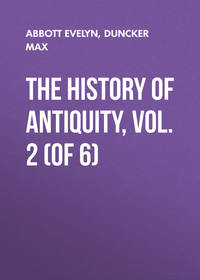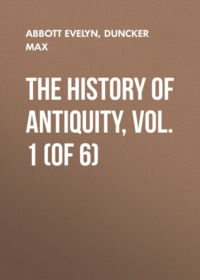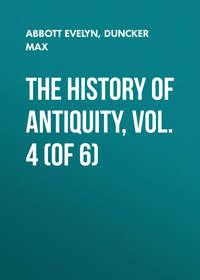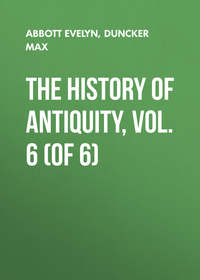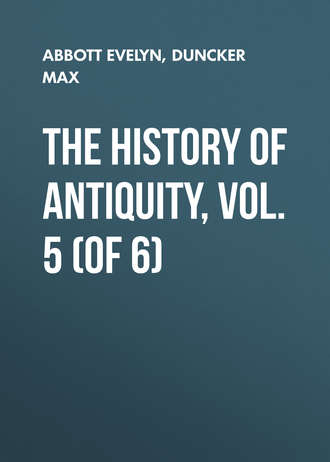 полная версия
полная версияThe History of Antiquity, Vol. 5 (of 6)
From the beginning the evil one was ranged over against Auramazda as his twin brother. He has created all that is evil, but nevertheless he is without any independent power of creation. If the Gathas express this merely in such a manner that they give prominence to Auramazda as the creator, they were as far from setting up a dualism of equally-balanced forces, as any other religion has been from attempting such a task, and carrying it out. The other fragments of the Avesta leave no doubt of the fact, that Angromainyu was not in a position to create the world according to his own will; he can only implant the form of evil in the good creation of Auramazda; he puts desolation, destruction, and death in the place of increase. The Vendidad quotes a whole series of lands which Auramazda created good, and enumerates the evils which the deadly Angromainyu brought into each: – into one winter, into another excessive heat; in one case vermin, in another disease, in a third beasts of prey. In the same way, in opposition to moral good, the evil one creates idleness, lies, lust, doubt, disbelief. An equally poised power of the two deities would have led to a direct conflict between them, which occurs nowhere in the Avesta; God and the devil only contend for the increase and injury of the world, and for the souls of men. The relative inferiority of the evil deity has not escaped the Greeks. "Some are of opinion," Plutarch says, "that there are two opposite deities, one of which framed the good, the other the evil. Others, however, name the better power the god, the other the demon, as Zoroaster the Magian. He calls one Oromazdes, the other Areimanius, and states that Oromazdes most resembles light among perceptible things, and Areimanius gloom and uncertainty."243 It is a later speculation, diverging from the Avesta, which formed the good and evil spirits into simple forces, and ranged them against each other with equal powers.244
In the Gathas we have the nucleus of the conceptions from which the reform of the ancient faith of Iran arose, but not in their original state. On the contrary, they have been systematised in the circles of the priests. Hence the contents and prescripts of other parts of the Avesta, which do not present a speculative tendency, are not on that account to be regarded as of later origin than the Gathas – least of all the invocations to the ancient deities. It was an essential object of priestly meditation to bring these old gods, which existed vividly before the soul of the nation, into harmony with the new faith. On every page of the Avesta it is clear that the priests of Eastern Iran did not attain to an accepted system in this direction; that the old gods remained in existence beside Auramazda, and the direct contest against the evil spirits, after the reform as before it, was carried on by Mithra, Verethraghna, and Vayu, Tistrya and Çraosha, while Auramazda is in the background, and sits somewhat passively on his golden throne in the heaven of Garonmana. When the Avesta was written down and collected, the ideas of the priests were still so naïve, or still preserved such a respect for the traditional forms of the gods of light and water, as they obviously lived in the mind of the people, that they represent Auramazda himself as offering sacrifice to Mithra,245 Anahita, Vayu, and Tistrya, with Haoma and the sacred bundle of twigs, in order to strengthen their power or carry out his own wishes, just as the gods of the Aryas in India offer sacrifices to one another. In India the old gods received a subordinate position as protectors of the world after the rise of Brahman, but in Iran this was not the case; nor were they brought into any genealogical connection with their new head Auramazda, though fire is occasionally spoken of in a figure as the son of Auramazda, and the earth (Armaiti) is once or twice called his daughter.246 The only bond of union between the new god and the old gods in the Avesta is the fact that Auramazda is made the creator of the old gods, and even of Mithra. Yet the old position of Mithra appears, when Auramazda says to Zarathrustra: "When I created Mithra, the lord of wide pastures, I created him as mighty to pray to, mighty to worship as myself." Tistrya also was created by Auramazda as worthy of adoration and praise as himself.247 We are already acquainted with Auramazda's command to Zarathrustra to invoke and worship Mithra, Vayu, the other ancient gods, and fire (p. 131). The existence and extent of this worship is proved not only by the prayers of the Yaçna, but also by the accounts of western writers which we have already examined.
As a compensation for the independent life of the ancient gods by the side of Auramazda, the priests surrounded his throne with six spirits, who were his associates and helpers. These are called Amesha Çpentas, i. e. the holy immortals; as good and wise kings they rule with Auramazda over the seven girdles of the earth,248 as in India the eight protectors of the world rule over the eight zones. The views out of which these spirits arose are found in the Gathas, but they did not receive their complete form till the Gathas had been composed and generally received. Plutarch tells us that, according to the faith of the Persians, Oromazdes had created six gods: the first, the god of good disposition (εὔνοια); the second, the god of truth (ἀλήθεια); the third, the god of order and law (εὐνομία); the three remaining deities were the gods of wisdom (σοφία), of wealth (πλοῦτος), and of delight in the beautiful (ἐπὶ τοῖς ϰαλοῖς ἡδέων). The two first, good disposition (Vohumano), and truth or truthfulness, we already found frequently mentioned in the Gathas, but chiefly as ideas rather than persons. With the priests Vohumano and Asha vahista (the most excellent truthfulness) became the Amesha Çpentas, who stand next to Auramazda. The Avesta speaks not only of the good way of Vohumano, but also of his acts, his dwelling, and his kingdom. According to the books of the Parsees it is his duty to protect the flocks. Asha vahista, as the truthful one, is the protector of fire, which points the right path, and, according to the Gathas, gives the decision in the contest against the liars. According to the books of the Parsees, Asha builds the bridge of Chinvat, to which the souls come after death, making it wide when the pious souls step upon it. Not less correctly does Plutarch describe the third Amesha Çpenta as the spirit of order and law. Kshathra, i. e. the kingdom, the dominion, is mentioned impersonally in the Gathas; and this idea the priests have elevated into Kshathra vairya, i. e. the good spirit of the desired dominion, of good order and law, which is the third Amesha Çpenta. Metals were allotted to him as the king of the Ameshas.249 The fourth figure in this circle, which Plutarch correctly describes as the spirit of wisdom, though he is wrong in calling it a god, is the earth spirit Armaiti. In the Rigveda Aramati (the earth) is a maiden worthy of praise, who, morning and evening, brings butter to Agni. In the Avesta Armaiti is "the beautiful daughter of Auramazda, the bearer (barethri) of cattle, of beasts of draught, and men;" with "her hands Auramazda performs pure actions," while the Gathas also ascribe to her special relations to the corporeal world.250 Among the priests the spirit of the "patient humble earth" has become the spirit of humility and piety. According to the books of the Parsees Armaiti gives patience and firmness.251 The fifth and sixth spirits also, whom Plutarch calls the gods of wealth and delight in the beautiful, were found in existence by the priests, and merely ranged by them in the circle of the Amesha Çpentas. These are Haurvatat and Ameretat. We saw how earnestly the Arians of India besought the gods for wealth and length of life; and in this matter the Arians of Iran were not behind them. Here, as there, the powers which could grant such gifts were elevated into special spirits, to whom, naturally, all that gave wealth and long life, good and healing plants and refreshing water, belonged. The good plants were the kingdom of Ameretat, refreshing water the domain of Haurvatat. In the fancy of the Arians of Iran good plants sprang from the tree of heaven, the Gaokerena, which grew in Ardviçura (p. 126); the water flowed down from this source in heaven, or came from Vourukasha, the lake on the divine mountain. Those two spirits, who ruled over plants and water, were brought by the system of the priests into the circle of the Amesha Çpentas; the province over which they ruled had long been apportioned to them. They were distinguished from the first four by the fact that those were personifications of moral ideas, these two were personifications of real goods.252 With wealth, prosperity and happy life is given, with length of life the complete enjoyment of its blessings, and so the Greeks could arrive at the conclusion that these two spirits were gods of wealth and delight in beauty. Thus Auramazda now ruled surrounded by six sacred forms. The semblance of this circle on earth was the throne of Cyrus and his successors, which was surrounded by the six tribal princes of the Persians.
The personification of ideas – the process of transforming old figures, and changing them into abstractions – did not come to an end with the Amesha Çpentas. We are acquainted with Çraosha, the warrior against the Daevas, his habitation on the divine mountain, his horses, his club, and how he fights at the side of Mithra, and keeps watch in the dark of the night against the demons (p. 121). Now it is he who first sang the sacred four Gathas of Zarathrustra, who first bound the sacred withes, "three twigs, five twigs, seven twigs;" he not only knows the sacred word; the sacred word is the body of Çraosha. Instead of the club which he held raised against the head of the Daevas, the invocations of the Avesta and the prayer Ahuna vairya are now the weapons with which he, "the pure lord of the pure," "advances the world." We remember the process by which the Arians in India came to represent Indra as smiting Vritra, and shattering his cave, not as formerly with the lightning, but with Brahman, the power of the prayer and the sacred acts. Obviously we have some influence of these old Arian conceptions of the mysterious power of prayer, and the control of the spirits possessed by the correct invocations and sayings against gods and spectres, when we find Çraosha fighting with the prayers of the Avesta, and in the Avesta the sacred word is praised as a Divine power —253 when Zarathrustra offers sacrifice to the good law.254 More liberal creations on the part of the system of the priests are the elevation of "excellent thought, knowledge, and conception," of "the long study," "and the thought of the pure man," which are invoked and praised in the Avesta, into Divine powers. Of not less abstract nature are other forms, like Rashnu razista, i. e. the most straight-forward justice,255 which, according to the Dinkart, tests the souls on the bridge of Chinvat; time, which is invoked as unlimited, as the ruler of the long periods, and like the genius of the five portions into which the priests divided the day. Of older origin, though also modified by the reform, is the invocation of the heights, which Mithra first illuminated with his light. In the Avesta this invocation is mainly addressed to the high "navel of the waters," the Divine mountain, which reaches to the sky, "on which were asked the holy questions," i. e. on which Zarathrustra has received the revelation; "by reason of the revelation of the sacred word we invoke the height, which preserved the knowledge."256 Many of the traditional forms of ancient times were partly modified by the priests and partly allowed to fade away. The goddess Drvaçpa, to whom the ancient heroes had sacrificed, they changed into the soul of the primeval bull, which Angromainyu had slain.257 Nairyoçangha, the Naraçansa of the Veda, an ancient name of the spirit of fire, which we learned to know in the Veda as the messenger of men to the heavenly beings, as priest and mediator between heaven and earth (IV. 39), appears in the Avesta merely as the messenger of the gods.258 The form of Vayu, the more ancient conception of which still plainly breaks through (p. 116), becomes merely the air "whose operation is on high;" and Ashi vanguhi, whom the ancient sacrificers and heroes invoked, together with Ardviçura, for victory, bears traces which can hardly any longer be recognised. We merely perceive that she could once confer power, fertility, beauty, and wealth. We saw above how she called Zarathrustra to her chariot, and promised splendour to his body, and long prosperity to his soul (p. 130). If the luminaries of heaven, in spite of the creation described to Auramazda, are extolled as "having no beginning," we have in this fact a glimpse of the old position of the spirits of light. The struggles of Tistrya against the demons of drought were allowed to remain (p. 120). Plutarch observes that, according to the doctrine of the Magians, Oromazdes had placed Sirius (Tistrya) as a watchman and advanced guard. On the other hand, the worship of the sun-god appears but faintly in the Avesta – in our fragments at any rate. Yet Herodotus informs us that with the Persians the neighing of horses at sunrise was regarded as a favourable sign from the gods, and Xenophon states that the Magians offered bulls to Zeus, but horses to the sun-god, and that on the journeys of the Achæmenids the chariot of Zeus went first, then that of the sun-god; both were white and crowned; and these were followed by a third chariot covered with purple, which as it seems was the chariot of fire. In the march of Xerxes to Hellas, according to the account of Herodotus, a sacred car, yoked with eight white horses, went before him; and ten sacred horses were led, clothed in the most beautiful trappings. Curtius represents the emblem of the sun as glowing over the tent of the last Darius, who invokes "the sun, Mithra, and the sacred eternal fire;" and he tells us of the chariot of Zeus in the army, yoked with white horses, behind which was led a horse of remarkable size, the horse of the sun, with golden bridle and white covering, like those before the chariot. Dio Chrysostom tells us that the Magians reared a yoke of Nisaean horses for Zeus, i. e. for Mithra, which were the largest and most beautiful in all Asia, and a horse for Helius.259 We can call to mind the battle-chariot of Mithra, "with golden wheels and silver spokes" (p. 110). These were imitations of the divine chariots of which the Greeks tell us, and if they were not in a position to distinguish accurately what belonged to Mithra (Auramazda does not come into the question), and what to Hvare Kshaeta (the sun-god) – Strabo is of opinion that the Persians called the sun Mithras260– we may still conclude with certainty from these statements, that the worship of Mithra and the sun-god remained more vigorous and effectual among the princes and nations of Iran than our fragments of the Avesta would allow us to assume, if the old invocations to Mithra, Tistrya, Haoma, Vayu, and Verethraghna had not been preserved in them. Yet the fragments do present us with an invocation to the sun-god, though weakened, it is true, and adapted to the new faith. "We celebrate the brilliant, immortal sun, whose horses are unwearied. When the sun gleams in heaven, the heavenly spirits come by hundreds and thousands, and spread the light over the earth for the salvation of the pure world, for the salvation of the pure bodies. As the sun rises, the earth purifies herself, and the fructifying waters of the springs, pools and lakes; the sun-god purifies all creatures that belong to Çpentomainyu. If the sun came not, the Daevas would slay all that inhabits the seven girdles of the earth, and the heavenly beings would not be able to withstand them; they could not drive them away. He who sacrifices to the sun in order to withstand the dark Daevas, the thieves and robbers, he sacrifices to Auramazda, to the Amesha Çpentas and to his own soul."261 In the time of the Sassanids, the worship of the sun comes definitely forward.
Plutarch states that the demon Areimanius had created an equal number of evil spirits to match the six good gods of Oromazdes, i. e. the Amesha Çpentas. The Vendidad mentions five of them: Andra, Çaurva, Naonghaithya, Tauru, and Zairicha,262 to which we have only to add Akomano, which has been mentioned already in the Gathas, in order to make up the number. They are all of them creations of the priests, partly invented to match the Amesha Çpentas, partly borrowed from older forms, which had lost their brightness among the Arians of Iran. Akomano, i. e. Bad disposition, is naturally the counterpart of Vohumano, or Good disposition: opposite Asha vahista, i. e. the most excellent truthfulness, the priests placed the demon Andra (Indra), i. e. an old Arian name which the Arians beyond the Indus had elevated to be the best warrior against the demons, the god of the storm. No special qualities of Andra are known or mentioned in the Avesta; the books of the Parsees can only say that he brings care and sorrow of heart to men, and makes narrow the bridge of Chinvat. The demon Çaurva is the opponent of Kshathra vairya, of order and law, of good dominion; hence, according to the Sad-der-Bundehesh, he leads kings astray into despotism, and nations into lawlessness and robbery. Naonghaithya is the opponent of Armaiti, the spirit of humility and piety; this spirit therefore, as the Bundehesh maintains, makes men impatient and proud; the science of languages claims to find in this name a Vedic name for the two Açvins, – Nasatya (IV. 42). Only the last two opposing spirits of the Amesha Çpentas, the opponents of Haurvatat and Ameretat, display, like these beings, real characteristics. If they are the spirits of water and plants, of prosperity and long life or immortality, then Tauru is the spirit of thirst and sickness, and Zairicha of hunger and death.263
If the ancient gods have preserved more lively traits than the Amesha Çpentas, the old demons have also more definite outlines than the opposing spirits. Such are the Daeva Apaosha, who parches up the land and keeps back the water from the earth; Çpenjaghra, the comrade of him who was struck by lightning; Zemaka, the spirit of the cold winter; and finally Azhi, who seeks to steal away the fire from men in the night. Among these evil spirits may further be reckoned a female demon Bushyançta, with long hands and of a yellow hue, who leads men astray into much sleep and idleness, who does not allow them to see the rise of the sun, and shortens the joy of existence;264 the three Daevas of drunkenness, Kunda, Banga, and Vibanga; the Daeva Buiti, the spirit of lies and falsehood, who deceives men;265 the spirit of flattery, Ashemaogha;266 and the very wicked Ashma "of evil glance," who attempts to slay the sleeping, and withstands Çraosha by night with terrible weapons.267 Very evil also is Açtovidhotu, i. e. the destroyer of bodies, and a female goblin, the spirit of the Daevas, the Druj Naçu. This spirit enters the body immediately after death, and exercises power over all who come in contact with it.
Under Auramazda are united the gods, the Amesha Çpentas, the rest of the Yazatas (those worthy of adoration), in opposition to the troops of hell, the Daevas, Druj, Pairikas and Jainis, which are led by Angromainyu. The first are found in the light of sunrise, in the clear gleam of the pure sky; the latter in the gloom of sunset, or in the distant clouds of the north; in burial-places, and where the dead are placed; in all corners into which the light of heaven does not pierce; in the dark abyss under earth; in "the worst place."268 On the summit of the mountain Arezura (Demavend, apparently), they take counsel how they are to turn the evil eye on men; how they can injure and slay them.269 To them belong gloom, cold, drought, the barren land and the wilderness, thorns and poisonous herbs, hunger and thirst, sickness, death, dirt, laziness, lying, sin. Theirs are the harmful beasts, the Khrafçtras; beasts of prey, wolves, serpents; all animals which live in holes and corners, lizards, scorpions, toads, frogs, rats, mice, gnats, and lastly mosquitoes, lice, and fleas.270 To the good spirits belong light, water, springs, rivers, the fruitful earth, good plants,271 trees, fields, pastures, good food, purity, truth, life in this world and the next; and theirs are the good animals, the animals of the flocks, the birds which nestle on the heights, and live in the clear air. The dog and the cock are worshipped in the Avesta as fighting with men against the Daevas. The first protects the flocks against the beasts of prey of Angromainyu. Of the cock the Avesta says: "The bird Parodarsh, which evil-speaking men call Kahzkataç (i. e. Kikeriki or the like), lifts up his voice in the last third of the night, roused by the holy Çraosha at every divine dawn. He cries: 'Rise up, ye men; praise the most excellent truth; drive away the Daevas.' Who gives a pair of these birds to a pure man, in purity and kindness, gives as much as if he had given a palace with a thousand pillars and a thousand beams, ten thousand windows, and a hundred thousand turrets." "And whoever gives to a pure man as much meat as makes the size of a Parodarsh" – the book of Auramazda tells us in another place – "I who am Auramazda will ask him no other question on his way to Paradise."272 According to the Avesta the dog and cock unite their powers against the Druj.273 The bird Asho-zusta fights against the Daevas, and the bird Karshipta (the sacred hawk) announces the good law in the garden of Yima. Two other mythical birds, the two eagles (çaena) of the sky, Amru and Chamru, are invoked as helpful powers.274 They nestle on the tree of life in the heaven. Besides the tree Gaokerena, which grows in Ardviçura and bears the heavenly Haoma, the Avesta has also the tree Viçpataokhma, which grows in the Lake Vourukasha, and bears all seeds. When Amru sits on this tree, the seeds fall down, and Chamru carries them away where Tistrya collects the water, who then rains down the seed with the water to the earth. In the book of kings of Firdusi, Simurgh (Çinmurv), the king of the birds, carries Rustem on his pinions over the broad earth as far as the sea of Chin (China) to the tree of life.275 A prophet of the Hebrews represents Jehovah as saying of Cyrus: "I summoned from the East the eagle, the man of my counsel."276 Xenophon tells us that Cyrus, and the Achæmenids who succeeded him, carried as a standard a golden eagle on a tall lance;277 and Curtius says, that a golden eagle with outspread wings was attached to the chariots of the Persian king.278
The fragments of the Avesta which have been preserved do not give us very full information on the sacrifices. The essential matters are hymns of praise and prayers. The chief sacrifice is offered to one of the old deities, Haoma, the supporter and protector of life. When Plutarch represents the Magi as pounding a certain herb of the name of Omomi in a mortar, with invocations to avert Hades, he gives a correct account of the supposed tendency of this sacrifice. According to the Avesta the utensils for this sacrifice – the mortar, cup and bundle of twigs – were found in every house. The sacrifice consisted in the offering, i. e. the elevation of the cup filled with the juice of the Haoma, during the recitation of the proper prayers. Beside this offering, which even now is offered twice each day by the priests of the Parsees, the fire is to be kept up perpetually, and fed with good dry wood and perfumes. The flesh of the sacrifice (myazda) is not often mentioned; yet the book of the law provides that a thousand head of small cattle must be offered in expiation of certain offences,279 and we are told in the invocations that the heroes of old time, from Thraetaona down to King Vistaçpa, had offered great sacrifices of animals to Ardviçura and Drvaçpa, in order to gain the victory, viz. 100 horses, 1000 cattle, and 10,000 head of small cattle. Herodotus tells us that the Magians, when Xerxes marched into Hellas, sacrificed 1000 oxen on the summit of Pergamus to Athene of Ilium, and at a later time white horses in Thrace; Xenophon maintains that the Persians sacrificed beautiful bulls to Zeus, i. e. to Auramazda, and horses to the sun, and burnt them whole; Athenæus tells that with the king of the Persians a thousand animals were daily slaughtered as sacrifices; camels, horses, oxen, apes, deer, and especially sheep. According to Arrian, the Magians who kept guard over the burial-place of Cyrus received a horse every month, and a sheep every day, for sacrifice.280 Herodotus has already told us, that the animals were led to a pure place, and when the sacrificer had invoked the god were killed, cut up, cooked, and then laid out on delicate grass. The Magian then sang the theogony, and after some time, the person who offered the sacrifice "carried away the flesh, and used it at his pleasure" (p. 85). Herodotus is better informed than Xenophon; according to the Avesta only the head of the animal belongs to the gods.281 Obviously, as the nature of the gods became more spiritualised – and the reform prepared the way for this – the sacrifice of animals was restricted in this manner, so that it consisted essentially in the offering of the animals, i. e. in the consecration of the flesh. We may conclude from the statement in Athenæus, that only consecrated flesh could be eaten at the court of the kings. Xerxes certainly would not have sacrificed to Athene, "a lying deity" of the Greeks, on the summit of Ilium; but he might very well have selected the last eminence in Asia Minor, "the many-fountained Ida," in order to offer there a sacrifice of 1000 oxen to Ardviçura for his victory beyond the sea – a sacrifice which corresponds exactly to the first offering made by Kava Huçrava and Kava Vistaçpa to the same goddess for victory over the Turanians.282


